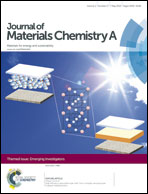Boosting photovoltaic performance of a benzobisthiazole based copolymer: a device approach using a zinc oxide electron transport layer
Abstract
The power conversion efficiency of organic photovoltaics of a benzobisthiazole/benzothiadiazole copolymer we have recently reported was significantly increased from 3.8% to 6.5%, by exploring the inverted cell structure (ZnO/polymer:fullerene/MoOx/Ag), the use of [6,6]-phenyl C71 butyric acid methyl ester (PC71BM), and optimizing film thickness, which demonstrates an improved correlation with time-resolved microwave conductivity.

- This article is part of the themed collection: Emerging Investigators

 Please wait while we load your content...
Please wait while we load your content...